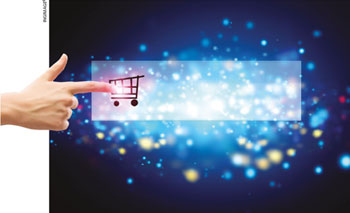DIGITAL RETAIL
THE E-SUPERMARKET BINGE
Ruwandi Perera weighs the pros and cons of digitalisation in supermarkets

When Michael J. Cullen dreamed of opening a supermarket, he had low prices, cash sales, self-service, larger stores and ample parking in mind. And when he opened King Kullen in New York in 1930, Cullen revolutionised the way Americans – and later on, the rest of the world – shopped.
Today, supermarkets are all the rage when it comes to grocery shopping – they’ve even evolved into hypermarkets where everything from tomatoes to winter coats can be paid for on the same bill. In addition to cash and credit sales, supermarkets now offer online shopping options where customers can choose to shop for their groceries from home… and have the goods delivered to their doorstep.
And while the Walmarts and Tescos of this world rule the roost, disrupters such as Amazon are going beyond online grocery shopping by capitalising on the shift that’s taking place in consumer habits – thanks to maturing digital natives who are seeking more convenient options, a wider choice and better prices.
AmazonFresh offers kerbside services whereby customers can visit specified pickup locations to transfer the groceries they ordered online straight into the boot of their vehicles. Since Amazon predominantly operates with small batch deliveries, these pickup sites are about one-fourth the size of a standard grocery store.
Bringing further innovation into the grocery retail space, Amazon Go presents yet another retail experiment where small stores with sensory technology and AI enable customers to walk around picking up whatever they need… and walk out without having to queue up at the cashier (who is non-existent).
The entire building is designed to track purchases in customers’ baskets and receive payments electronically using predefined payment mechanisms.
Sounds amazing, right?
Well, it gets even better!
In China, shoppers can walk into virtual shops that have layouts that are similar to any physical supermarket by connecting themselves to a retailer’s app through their smartphones. Yihaodian is one such retailer that set up 1,000 temporary virtual stores across China: in parks, campuses, parking lots and even Tiananmen Square. Talk about real estate savings!
Some supermarkets in Shanghai use a technology called facepay, which enables customers to pay by simply having their faces and hands scanned. And providing a solution to cashier traffic, Kroger has rolled out QueVision to help determine the number of checkout lanes that should be opened based on body heat in a store as measured by infrared cameras installed around it.
The game is certainly changing with some countries adapting quicker than others. Clicks may not be overtaking bricks but they’re certainly kicking the industry up a few notches. And with retailers capitalising on IoT, customers are changing the way they shop, spend, commute and eventually live. Big data is pretty big in the supermarket space where stores are using behavioural data to streamline inventory management. For instance, a huge drop in sales of a particular product will signal a supplier to minimise the volumes delivered in the next shipment and vice versa.
Customers will also be able to log into a retailer’s app and alert a store when a desired product isn’t available. Moreover, customer data can be tracked to find out which product combinations work best for promotions and ‘two for one’ offers.
Digital enactments in supermarkets have also enabled retailers to provide customers with more information about products. Every brand has a story, and customers will know the origins of the product, its ingredients, how to consume or use it and even its environmental impact… simply by looking at a suspended screen located near the product.
However, while digital can make things exciting, there are certain elements in conventional grocery retailing that cannot quite be replicated virtually – for instance, the smell of freshly baked bread wafting through a store, the ability to touch and feel the freshness of fruit and the satisfaction of seeing an in-store butcher carving your favourite cut of meat.
While most millennials and Generation Z prefer to lead faster lives with less time spent shopping, and more time spent enjoying the products they purchase, the 2014 Nielsen Global Retail Format Preferences Survey indicates that a majority (61%) of global shoppers find supermarket and grocery store visits enjoyable. Another 57 percent say that grocery shopping represents a fun day out for the family.
On the other hand, digital driven shopping is literally making way for ‘the return of the milkman’ to our doorsteps like in the good old days. So it’s a blurry picture right now… until we find the perfect balance between the conventional and digital.






Leave a comment